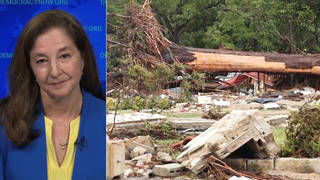
At least 82 people have died and dozens are still unaccounted for after flash flooding in central Texas over the weekend, when the Guadalupe River rose about 26 feet in less than an hour on Friday amid torrential downpours. At least 10 girls who attended Camp Mystic, a girls’ summer camp located on the banks of the river, are among the missing. In Kerr County, the most devastated area, at least 40 adults and 28 children have died. The speed and scale of the natural disaster has raised questions about why officials weren’t better prepared, and whether the Trump administration’s cuts to scientific positions exacerbated the situation.
“The National Weather Service, like a lot of federal agencies, went through significant loss of staff back in the spring,” says retired NOAA meteorologist Alan Gerard, now the CEO of Balanced Weather, which provides critical weather and climate alerts. Gerard says that while it appears there was appropriate staffing ahead of the Texas flood, the impact of current budget cuts and even deeper reductions being considered by the administration are a cause for concern. “We still have all of hurricane season to deal with,” he says.
Transcript
AMY GOODMAN: The death toll from the catastrophic flooding in central Texas has reached 82 people. Dozens are still unaccounted for following flash flooding over the weekend. The Guadalupe River rose some 26 feet in less than an hour Friday amidst torrential downpours. The rain followed a long drought in the region that left the soil bone dry and increased the potential for flooding. Among the missing are at least 10 girls who attended Camp Mystic, located on the banks of the river. In Kerr County, the most devastated area, at least 40 adults and 28 children have died.
This is Kerrville resident Scott Walden describing the terrifying moments before he was swept almost 200 feet by raging floodwaters.
SCOTT WALDEN: About 6:30 in the morning or 6:00 in the morning, we heard some thumps. I had a shed around the corner, and the shed started banging against the house. And my wife jumped up, and she looked out the back, and she said, “There’s a river back there.” And so we ran to the front. And by the time we grabbed two dogs and a set of keys, the water had risen, covered four motorcycles and flooded a jeep and then flooded a big truck.
AMY GOODMAN: Rescue workers and volunteers are continuing their search for the fourth day. Questions and anger are mounting over local authorities’ preparedness warnings ahead of the disaster, as well as the current and future role of federal authorities. Experts say staff shortages at local offices of the National Weather Service and the lack of a local severe weather warning system, which the state wouldn’t fund, may have been part of the problem.
President Trump has said he plans to phase out FEMA by the end of this year’s hurricane season and shift those responsibilities to states. A reporter asked Trump about his plans for FEMA Sunday.
REPORTER: Are you still planning to phase out FEMA?
PRESIDENT DONALD TRUMP: Well, FEMA is something we can talk about later, but right now they’re busy working, so we’ll leave it at that.
AMY GOODMAN: Trump was also asked if the federal government should hire back any of the meteorologists that have been fired in recent months, to which President Trump said, quote, “I wouldn’t know that, and I would think not,” unquote.
Meanwhile, the Trump administration’s 2026 budget promises to dismantle critical scientific research programs that could improve early warning capabilities and upgrade technology. That’s according to our next guest, who knows these programs extremely well. Dr. Alan Gerard is the CEO of Balanced Weather and a retired NOAA meteorologist with more than three decades of experience. He’s the former head of the Warning Research and Development Division of the NOAA National Severe Storms Laboratory. He’s been following the flooding closely on his Substack, Balanced Weather.
Welcome to Democracy Now!, Alan Gerard. Thank you so much for being with us. This is absolutely devastating. It looks like well over a hundred people have died. About a quarter of them are children. We just heard Trump’s response, both on not hiring meteorologists that have been fired and not clear whether FEMA will continue, yet we hear local officials saying how desperate they are to continue to work with the National Weather Service. Can you talk about what took place and the fact that part of the severe flash flooding was caused by a drought?
ALAN GERARD: Yeah. So, we’ll start with the flash flood. That area of the country is very vulnerable to flash flooding due to a number of factors, partially just due to the proximity of the Gulf and the moisture that can come up from there. And then also, that soil in central Texas, which is also very hilly, when there’s a prolonged drought, becomes almost like concrete, so the heavy rainfall just runs off into these river basins that, you know, runs through the Hill Country and can create these massive flood waves, like what we saw, unfortunately, on the south fork of the Guadalupe.
AMY GOODMAN: And can you talk about the National Weather Service — in a moment, we’re going to talk about the new law, the budget law that went into effect — but the National Weather Service and the depletion of jobs and what is missing, what — most importantly, as we look forward, what is needed?
ALAN GERARD: Yeah, so, the National Weather Service, you know, like a lot of federal agencies, went through significant loss of staff back in the spring with federal buyouts under the plans of DOGE and the Office of Personnel Management, and a number of experienced staff were lost. The office in Austin/San Antonio, which is the office that was responsible the flash flood warnings in this case, have lost two of their most senior staff as part of that: their warning coordination meteorologist, who’s responsible for the outreach to emergency management, and the science and operations officer, who oversees the operations and training of the meteorology staff. So, obviously, those are critical positions.
I will say that it does appear like, overall, for the actual event, when it occurred, the warnings went out as they should have, that the office was staffed appropriately. But it is definitely a concern overall, you know, how well the staff, overall, would have been prepared, given those losses, and how well they’ll be prepared going forward, as we still have all of hurricane season to deal with.
And then, kind of from a longer-term perspective, as you mentioned, the 2026 presidential budget proposal would make significant cuts to NOAA, including completely eliminating NOAA’s research line office, the Office of Oceanic and Atmospheric Research. And obviously, if that were to happen, all of this research that’s being done to try to improve warnings for events like this would be terminated.
AMY GOODMAN: In fact, isn’t this weather research lab in Norman, where you are, Norman, Oklahoma, in the crosshairs of the cuts at the federal level, where you worked as you were former head of the warning research unit there?
ALAN GERARD: Yes, the division that I was in charge of actually does a lot of research to improve flash flood warnings. The system that the National Weather Service uses to, in real time, estimate the probability of flash flooding and help issue their warnings was developed here in our division at the National Severe Storms Lab. And under the current presidential budget, it would be closed along with all of the other NOAA weather and climate labs.
AMY GOODMAN: I mean, from the heat dome that we’re seeing in this country and in Europe — I was just in Geneva; it’s just scalding — in Spain, the fires outside Barcelona, can you end by talking about how serious the threat of climate change is right now to the planet, beginning right there in Texas, in this horrific flash flooding event that has killed, it looks like, well, over 80, probably over a hundred, half — a quarter of them children?
ALAN GERARD: Yeah, as someone that’s been doing this for 35 years, I’ll admit that early in my career I was a little skeptical about how much climate change would actually impact the weather events that I would see in my career. But after doing it for three decades and seeing the research and actually watching the weather every single day and seeing the increased frequency of these type of events, it’s a huge concern for me. And, you know, that’s part of the reason why, even in retirement, I’m doing the Substack, trying to speak out about this, because I’m extremely concerned about the threat of climate change and having more increased flash floods, wildfires, heat waves. And regardless of the politics of it, we need to be prepared. And really, my focus is just trying to improve our resilience and our ability to be prepared for these kind of events. And obviously, I strongly believe that having a robust NOAA and a robust National Weather Service, a robust research program from NOAA, is an important part of all of that, of keeping us as safe as we can be as the climate continues to change.
AMY GOODMAN: This final point, Alan Gerard, Elon Musk’s own AI bot Grok also blamed the rising death toll in Texas on cuts made by the Trump administration and DOGE — right, Doge that was run by Elon Musk — saying, “While absolute proof of counterfactuals is impossible, evidence strongly suggests yes: Pre-cut NWS” — National Weather Service — “models accurately predicted similar floods (e.g. Vermont 2023). 2025 cuts reduced staff and balloon launches by 25%, leading to underestimated rainfall forecasts for Kerr County. Experts, including ex-NOAA heads, say this delayed warnings, preventing Camp Mystic evacuation and contributing to the 24 deaths. Sources: PBS, NPR, Guardian.” Your final 30 seconds. Alan Gerard, on Democracy Now! today.
ALAN GERARD: Not to contradict Grok, but I will say that this event did have quite a bit different than, like, the Vermont event that it cited. This was a very small-scale event that was very difficult for the computer models and for humans to really forecast, you know, very far in advance. Having said that, there is no question that the Weather Service is being left in a more vulnerable state. And whether it was this event or whether it’s going to be with future hurricane flood events like this, we’re needlessly putting ourselves into increased danger by these cuts to NOAA and the Weather Service and NOAA Research. And hopefully, you know, this is a horrible tragedy that, you know, is really unspeakable, but if anything positive could come out of it, maybe it will be a reconsideration of some of these cuts.
AMY GOODMAN: Well, I want to thank you so much for being with us from Norman, Oklahoma, Alan Gerard, retired NOAA — that’s National Oceanic and Atmospheric Administration — meteorologist, former head of the Warning Research and Development Division of the NOAA National Severe Storms Laboratory, runs the Substack Balanced Weather.
Up next, we’ll speak with The Nation's John Nichols about how “Republicans Just Voted to Do Immoral and Irreparable Harm to the United States” with the new Trump budget law and how the fossil fuel industry will benefit. Finally, we'll talk about what’s happening in Gaza as the prime minister of Israel meets with President Trump for the third time in Trump’s second term. Stay with us.
[break]
AMY GOODMAN: “Do You Believe in Rapture?” by Thurston Moore, performing at Smith College years ago.












Media Options